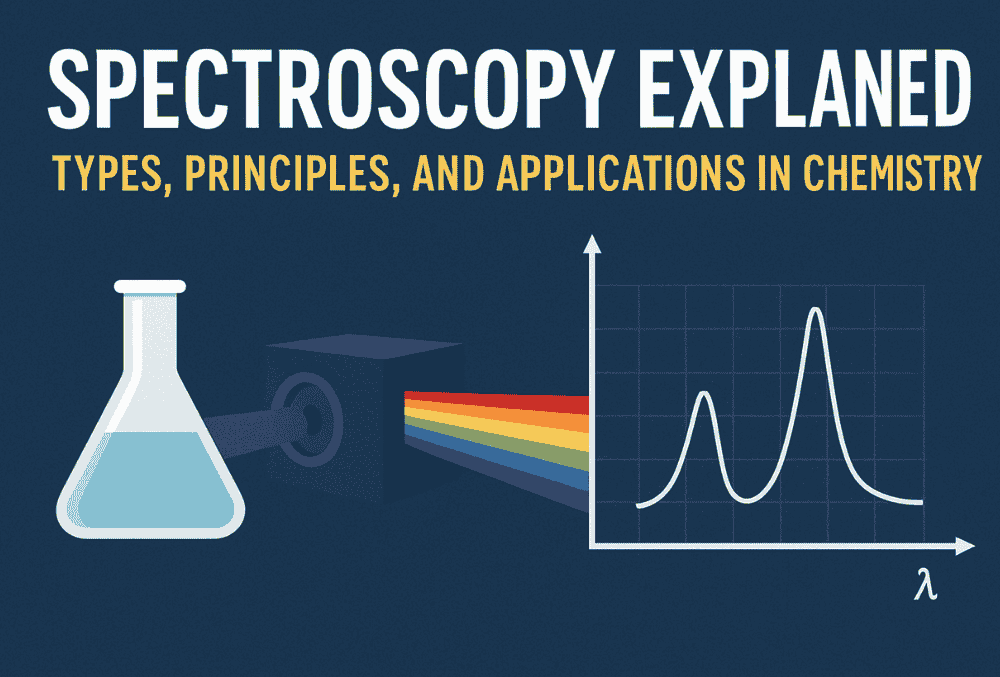Introduction
Spectroscopy is one of the most essential analytical techniques in modern chemistry. It allows scientists to study how atoms and molecules interact with light, providing valuable information about their structure, composition, and chemical behavior. Whether it’s identifying an unknown compound, determining molecular structures, or monitoring environmental pollutants, spectroscopy plays a critical role in both academic and industrial chemistry.
This comprehensive guide explores the principles of spectroscopy, examines the various types of spectroscopy used in chemistry, and highlights their applications across science, industry, and research. For students aiming to master chemistry concepts, especially for higher studies, working with an A Level Chemistry Tutor can help in understanding complex topics like spectroscopy more effectively.
What is Spectroscopy?
At its core, spectroscopy is the study of the interaction between electromagnetic radiation and matter. Every atom and molecule can absorb, emit, or scatter light at specific wavelengths. The resulting patterns, called spectra, act as a molecular “fingerprint” that allows chemists to identify substances and determine their structure.
In simpler terms, spectroscopy lets scientists “see” molecules without physically touching them, making it a non-destructive analytical technique. This is why spectroscopy is widely used in research labs, pharmaceuticals, environmental monitoring, and even space exploration.
Principles of Spectroscopy
The underlying principle of spectroscopy is based on energy transitions within atoms and molecules. Matter exists in discrete energy levels, and when it interacts with radiation:
-
Absorption: Atoms or molecules absorb specific wavelengths of radiation, causing electrons or molecular vibrations to move to higher energy levels.
-
Emission: Excited atoms or molecules release energy as they return to lower energy levels, producing emitted light.
-
Scattering: Radiation can also bounce off molecules, and this scattered light provides information about molecular vibrations and structure.
For instance, in Infrared (IR) spectroscopy, molecules absorb infrared radiation, causing vibrations in their chemical bonds. In UV-Visible spectroscopy, electrons jump between energy levels when they absorb UV or visible light. Each type of spectroscopy measures these energy interactions in a specific range of the electromagnetic spectrum, providing unique and detailed chemical information.
Types of Spectroscopy in Chemistry
Spectroscopy encompasses several techniques, each suited for different analytical purposes. Here’s an in-depth look at the major types:
1. Infrared (IR) Spectroscopy
-
Principle: IR spectroscopy works by passing infrared radiation through a sample. Molecules absorb specific IR wavelengths, which causes their bonds to vibrate — stretching, bending, or twisting.
-
Applications: It is primarily used to identify functional groups within organic compounds, such as hydroxyl (-OH), carbonyl (C=O), or amine (-NH₂) groups.
-
Example: If a compound contains an alcohol group, the IR spectrum shows a broad absorption peak around 3200–3600 cm⁻¹. Similarly, a carbonyl group appears around 1700 cm⁻¹.
-
Importance: IR spectroscopy is invaluable for quickly identifying molecular components and confirming chemical structures in organic chemistry labs.
2. Ultraviolet-Visible (UV-Vis) Spectroscopy
-
Principle: Molecules absorb ultraviolet or visible light, which promotes electrons to higher energy orbitals (electronic transitions).
-
Applications: UV-Vis is often used to determine the concentration of substances in solutions, using the Beer-Lambert law, which relates absorbance to concentration.
-
Example: Measuring the concentration of nucleic acids (DNA/RNA) in a solution or monitoring protein content in biochemistry experiments.
-
Importance: This technique is fast, non-destructive, and widely used in biochemistry, chemical analysis, and quality control.
3. Nuclear Magnetic Resonance (NMR) Spectroscopy
-
Principle: Certain atomic nuclei, such as hydrogen-1 (¹H) or carbon-13 (¹³C), behave like tiny magnets. When placed in a strong magnetic field, they absorb radiofrequency radiation, producing signals that reflect their chemical environment.
-
Applications: NMR provides detailed information about molecular structure, including the arrangement of atoms and the connectivity of functional groups.
-
Example: In ethanol, NMR can differentiate between CH₃, CH₂, and OH groups, allowing chemists to confirm the molecule’s structure.
-
Importance: NMR is considered the gold standard for structure elucidation in organic chemistry and is crucial in drug development and chemical research.
4. Mass Spectrometry (MS)
-
Principle: Although technically not a spectroscopy technique, mass spectrometry is often discussed alongside spectroscopy. Molecules are ionized, and the resulting ions are separated based on their mass-to-charge ratio (m/z).
-
Applications: MS identifies molecular weight and provides fragmentation patterns to deduce molecular structures.
-
Example: Pharmaceutical labs use MS to detect trace impurities in drug samples or confirm the molecular weight of synthesized compounds.
-
Importance: MS is highly sensitive and can analyze very small amounts of a sample, making it invaluable in modern analytical chemistry.
5. Atomic Absorption and Emission Spectroscopy
- Principle: Individual atoms absorb or emit light at specific wavelengths. In atomic absorption spectroscopy (AAS), light absorption indicates the presence of specific elements. In atomic emission spectroscopy (AES), emission patterns indicate elemental composition.
- Applications: Widely used for detecting metals and trace elements in samples.
- Example: Measuring calcium content in milk or detecting heavy metals such as lead or mercury in water samples.
- Importance: These techniques are critical in environmental monitoring, food safety, and clinical analysis.
6. Raman Spectroscopy
-
Principle: Raman spectroscopy measures the inelastic scattering of light as it interacts with molecular vibrations. The resulting shift in wavelength provides a molecular fingerprint.
-
Applications: Identifying chemical bonds and molecular structures, especially in compounds where IR spectroscopy is limited.
-
Example: Used in pharmaceutical quality control, forensic analysis, and material science.
-
Importance: Raman spectroscopy works well for aqueous solutions and solid samples and complements other spectroscopic techniques.
Applications of Spectroscopy
Spectroscopy is widely applied across chemistry, industry, medicine, and research:
-
Identifying Unknown Compounds: Chemists compare spectral data with reference spectra to confirm the identity of unknown substances.
-
Molecular Structure Determination: IR and NMR spectra provide detailed insights into how atoms are connected within a molecule.
-
Quality Control in Industry: Food, pharmaceutical, and cosmetic industries rely on spectroscopy to ensure product purity and detect contaminants.
-
Environmental Monitoring: Detects pollutants, heavy metals, and greenhouse gases in water, air, and soil samples.
-
Medical Diagnostics: Techniques like MRI (based on NMR) or UV-Vis blood tests help diagnose diseases and monitor health.
-
Forensic Science: Spectroscopy identifies drugs, explosives, and toxins at crime scenes, providing critical evidence.
Spectroscopy is not just a lab technique; it is a bridge between theory and practical applications, helping scientists analyze, monitor, and innovate.
Spectroscopy in GCSE and A Level Chemistry
-
GCSE Chemistry: Students are introduced to basic concepts like flame tests, absorption and emission of light, and simple molecular identification.
- A Level Chemistry: Students study IR, NMR, Mass Spectrometry, and UV-Vis in detail. They learn to interpret spectra, solve problems, and apply these techniques in experimental scenarios.
For students aiming to excel, working with an A Level Chemistry Tutor can provide targeted guidance, practice questions, and personalized explanations to master challenging topics like spectroscopy efficiently.
Advantages of Spectroscopy
-
High Accuracy and Sensitivity: Provides precise chemical information even at trace levels.
-
Non-Destructive: The sample remains intact after analysis.
-
Small Sample Requirement: Only micrograms of material are needed for many techniques.
-
Versatility: Applicable across chemistry, biology, physics, and industrial applications.
Limitations of Spectroscopy
-
High Cost: Instruments like NMR spectrometers are expensive and require maintenance.
-
Expertise Required: Skilled operators are necessary to interpret complex spectra.
-
Sample Purity: Some methods require pure samples to avoid interference.
The Future of Spectroscopy
Spectroscopy continues to evolve with advances in technology:
-
Portable spectrometers allow field analysis in agriculture, environmental science, and medicine.
-
Artificial intelligence assists in rapid spectrum interpretation and pattern recognition.
-
Space exploration: Spectroscopic instruments analyze planetary atmospheres and detect chemical compositions on other planets.
These innovations are making spectroscopy faster, more accessible, and increasingly integral to scientific discovery.
Conclusion
Spectroscopy is a cornerstone of modern chemistry and science in general. It allows scientists to see the invisible world of molecules, identify compounds, determine molecular structures, and monitor the environment.
For students preparing for A Levels, mastering spectroscopy is essential for both exams and practical lab skills. Working with an A Level Chemistry Tutor can provide personalized guidance, clarify complex concepts, and ensure exam readiness.
This blog is brought to you by Bright Mind Tutors, committed to helping students excel in chemistry and achieve academic success.




